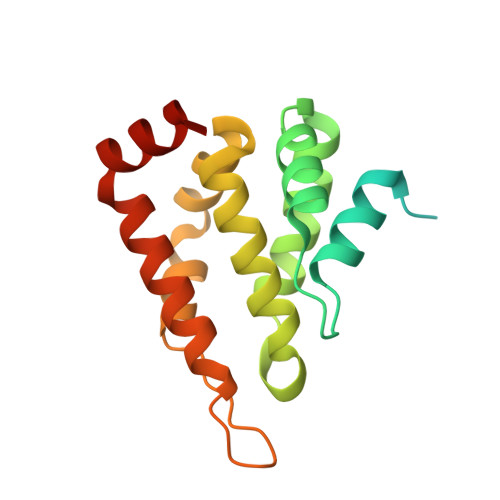Crystallographic analysis of the ENTH domain from yeast epsin Ent2 that induces a cell division phenotype.
Costakes, G.T., Sen, A., Aguilar, R.C., Stauffacher, C.V.(2013) Protein Sci 22: 755-761
- PubMed: 23553749
- DOI: https://doi.org/10.1002/pro.2259
- Primary Citation of Related Structures:
4GZC, 4GZD - PubMed Abstract:
Epsins are eukaryotic, endocytic adaptor proteins primarily involved in the early steps of clathrin mediated endocytosis. Two epsins exist in Saccharomyces cerevisiae, Ent1 and Ent2, with single epsin knockouts being viable, while the double knockout is not. These proteins contain a highly conserved Epsin N-terminal homology (ENTH) domain that is essential for cell viability. In addition, overexpression of the ENTH domain of Ent2 (ENTH2) was shown to play a role in cell division by interacting with the septin organizing, Cdc42 GTPase activating protein, Bem3, leading to increased cytokinesis failure. In contrast, overexpression of the ENTH domain of Ent1 (ENTH1) does not affect cytokinesis, despite being 75% identical to ENTH2. An ENTH2(N112D, S114E, E118Q) mutant that switches residues in loop 7 to those found correspondingly in ENTH1 was incapable of inducing the cytokinesis phenotype. In order to better understand the role of loop 7 in the ENTH2-induced phenotype at a molecular level, X-ray crystallography was used to elucidate the structures of yeast ENTH2(WT) and ENTH2(DEQ). Our results indicate that mutations did not affect the conformation of loop 7, but rather introduce an increased negative charge on a potential interaction interface. Morphological analysis of cells overexpressing ENTH2 loop 7 mutants showed that the cytokinesis failure phenotype was abolished by the single mutants N112D, E118Q, and to a lesser extent by S114E. Taken together, our results indicate that the interaction surface that contains loop 7 and the specific nature of these residues are crucial for ENTH2 involvement in cytokinesis. This research provides insight into a molecular mechanism by which ENTH2, but not ENTH1, overexpression in yeast leads to cell division defects. Structural data of WT and mutant ENTH2 domains along with in vivo phenotypic analysis of ENTH2 overexpressing cells indicate that the biochemical nature of three loop 7 residues is crucial for its role in cytokinesis.
- Department of Biological Sciences, Purdue University, West Lafayette, Indiana 47907, USA.
Organizational Affiliation:


















